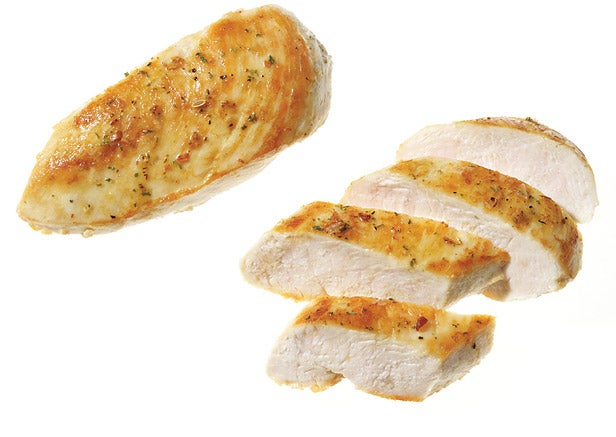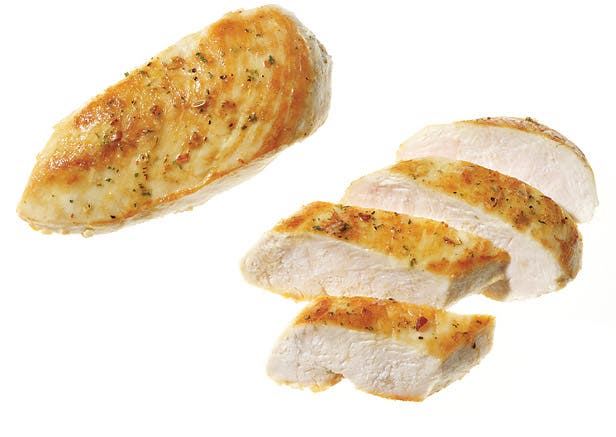Your Fit Food Pyramid


1. Protein (8 – 12 servings per day)
Depending on the intensity and frequency of your workouts, your protein needs could be up to double those of the average woman (up to 1.6 grams per kilo, or about 0.75 grams per pound). That, combined with protein’s appetite-suppressing effects, makes it absolutely essential for active women. The key is to distribute your protein evenly throughout your day to make sure you are always building up, not tearing down, muscle.
1 serving = 10 g protein or about 1 1/2 oz lean meat, 10 oz milk or soy beverage, 3/4 cup yogurt, 1/3 cup cottage cheese, 2 egg whites or 2 oz tofu

2. Non-Starchy Vegetables (5 – 7 servings per day)
As the foundation of any healthy diet, non-starchy vegetables such as spinach, asparagus, cauliflower, onions and bok choy are fiber-rich, low-calorie disease fighters that will keep you both healthy and lean. Aim to include at least a handful of veggies at both lunch and dinner each day, and emphasize a variety of colors to give your diet a broad spectrum of vitamins, minerals and antioxidants.
1 serving = 1/2 cup cooked or 1 cup raw, leafy greens

3. Whole Grains And Starchy Vegetables (2 – 6 servings per day)
A key source of carbohydrates to fuel your workouts, your whole-grain and starchy vegetable needs will vary with your training. If you are going heavy on cardio, or you’re involved in endurance sports, you’ll probably want to include foods like oatmeal, quinoa and sweet potatoes at each meal. If you’re trying to shed weight before competition, or focusing on weight training more than cardio, then you can bring your intake down a few notches.
1 serving = 1/2 cup cooked grain, sweet potato, squash, etc., or 1 oz cereal or oatmeal

4. Fruits (2 – 4 servings per day)
Often thought of as a nutritional no-no because of the sugar content, most fruit actually has a limited impact on blood glucose (sugar) levels, and the fiber and antioxidants are tough to beat. On top of that, research suggests that consuming foods high in water (like fruits, veggies, soups, and yogurt) can help you to feel more full, contributing to weight loss over time. Be sure to focus on whole fruits, rather than juice, whenever possible.
1 serving = 1 fist-sized piece of fruit

5. Healthy Fats (2 – 4 servings per day)
Still underappreciated after all these years, healthy fats like olive oil, ground flaxseeds, avocadoes and pumpkin seeds are critical for maintaining a healthy metabolism, fighting belly fat and preventing heart disease. Whether it’s olive oil on your salad at dinner, or a handful of almonds mid-afternoon, try to include a source of healthy fats at most meals and snacks.
1 serving = 2 tsp oil, 1/4 avocado, 2 tbsp nuts or 4 tsp seeds)

6. Supplements (1 – 3 servings per day)
With mounting evidence that high doses of some vitamins might not be good for everyone, it’s important to evaluate your supplement routine carefully. For most, a daily dose of immune system-boosting vitamin D makes good sense, since the sun is simply too weak most of the year to produce it naturally in our skin, and food sources are scarce. Beyond D, fish oil supplements are valuable for heart and brain health, and to control inflammation in your hard-working joints, while protein supplements such as whey, casein or soy protein powder can boost muscle recovery.

7. Refined Carbohydrates (1 serving per day)
While it might be easy to consider these foods as off limits, refined carbs can be helpful during recovery, or right before a workout if you’re running low on fuel. If you do include them in your diet, try to make healthier choices more often, like fig bars, banana bread, or dark chocolate, versus the junky stuff (think: soda) that is virtually nutrient-free.